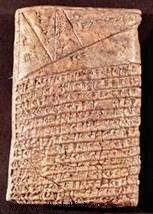 The number zero was first used by the Babylonians during the second millennium BC, before being reinvented by the Mayans and then by the Hindus. But it is the Arabs who will integrate it into their numbering system, to spread it throughout Europe during the tenth century. Quickly essential in mathematics, it will even take on a mystical dimension...
The number zero was first used by the Babylonians during the second millennium BC, before being reinvented by the Mayans and then by the Hindus. But it is the Arabs who will integrate it into their numbering system, to spread it throughout Europe during the tenth century. Quickly essential in mathematics, it will even take on a mystical dimension...
The origins of the number zero
 Indispensable tool of modern numeration, the zero however, appeared much later than the other figures. Only three peoples invented it, independently of each other:the Babylonians first, around 2000 B.C., then the Mayas , in the 3rd century, and finally the Hindus around the fifth century. What do these peoples have in common? The position number system, which cannot do without a sign indicating an absence.
Indispensable tool of modern numeration, the zero however, appeared much later than the other figures. Only three peoples invented it, independently of each other:the Babylonians first, around 2000 B.C., then the Mayas , in the 3rd century, and finally the Hindus around the fifth century. What do these peoples have in common? The position number system, which cannot do without a sign indicating an absence.
Furthermore, if the Greeks appreciated it for astronomy (it would be the symbol of the celestial vault) it was the Indian mathematicians who knew how to exploit zero as a number but also as an operator.
Forms and distribution
The zero did not always have the round shape that we know today:the Mayans used an oval sign in which an arc was inscribed. The Indians alternately described a point or a circle, this last sign having then been taken up by the Arabs who transmitted it to the Europeans in the 10th century, along with the other figures. The adoption of the Indian decimal system including zero would greatly facilitate conventional arithmetic operations (addition, subtraction, multiplication, division...). This high-performance tool, which for a long time remained confined to the borders of the Indian subcontinent, was to have an international destiny thanks to the circulation of Arabic calculation works, particularly in Europe from the 12th century. It will revolutionize the history of mathematics.
A number that is both empty and infinite
The number 0 of course means absence, but it also serves as a point of reference; thus, he arbitrarily sets the melting point of the ice, but also the starting point in geometry. It was not until the beginning of the 20th century that zero was given the status of number , with however some amusing peculiarities:it is the only number equal to its opposite, both positive and negative, neutral when added to another number and absorbing in multiplication. But the most intriguing is its use in divisions:initially not tolerated because it has no meaning, division by zero allows in modern mathematics to reach infinity. No more no less ! Zero, a symbol of both everything and nothing, a veritable sun filled with energy, is even sometimes considered the expression of the divine...
To go further
- The great math novel:from prehistory to the present day, by Mickaël Launay. Donot, 2016.
- A History of Mathematics:Roads and Mazes, by Amy Dahan-Dalmédico. Science Point, 1986.
